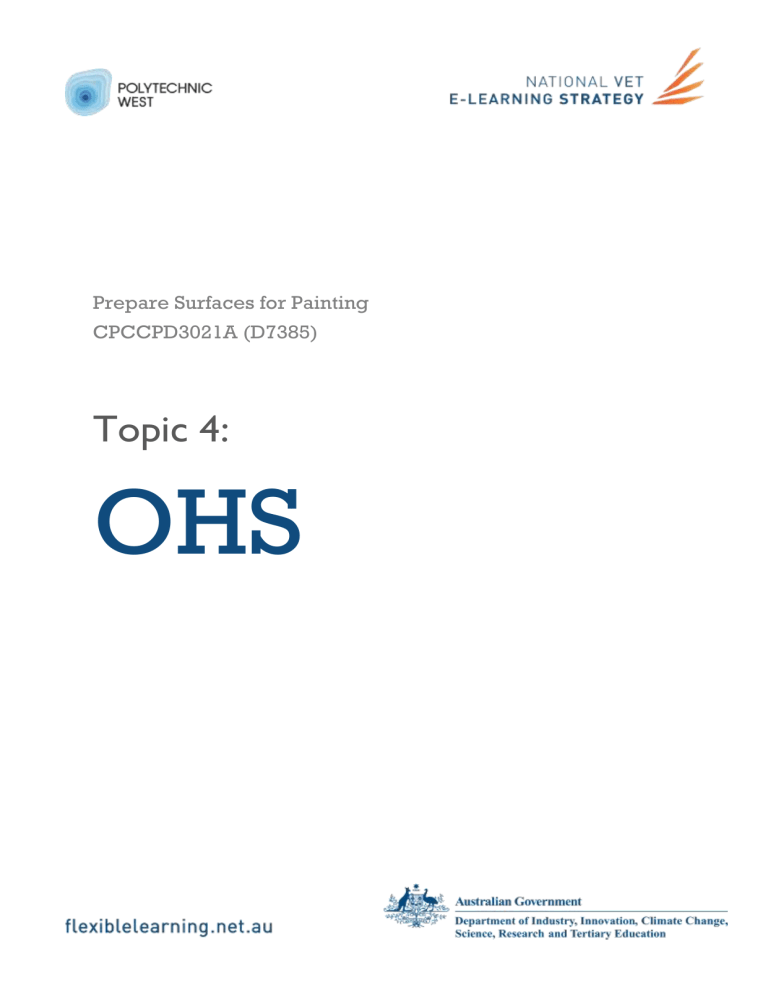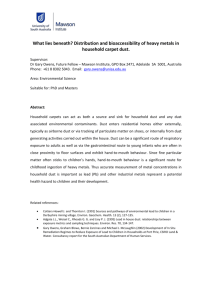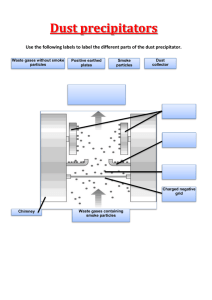topic4-ohs - E-Learning for Participation & Skills Wiki

Prepare Surfaces for Painting
CPCCPD3021A (D7385)
Topic 4:
OHS
Contents
Page 2 of 9
Introduction
Main Painter: Occupational health and safety… why do I have to learn this every time?
Helper Painter: Because it could be a matter of life or death!
Main Painter: One of my friend’s mates, who used to work in the WA town of Wittenoom many years ago, died from mesothelioma the other day. It’s pretty sad for the families left behind.
Helper Painter: As painters, we may come in contact with asbestos and other hazardous dusts in our line of work. That’s why it’s so important to know how to protect ourselves.
Dust - Introduction
As a result of dry or mechanical sanding of a surface, there is generally an unpleasant byproduct called “dust”. This can include filler dust and household dust. These dusts can cause coughing, itchy eyes, sneezing and general discomfort. To protect ourselves from dust, we have two choices.
Dust - Prevention
SUPPRESS DUST
The following methods may be used to suppress or stop dust being generated.
The method you choose will depend on the nature of the dust and the type of hazard that it presents.
• Water spray to wet the dust
• Hose down work area
• Vacuum
• Dust collectors
• Restrict/limit use of power tools
Example Equipment:
Festool Cleantex Machine
Dust - Protection
WEAR PPE
A range of Personal Protective Equipment (PPE) is available to protect us:
• Overalls
• Shoes
• Glasses
Page 3 of 9
Hazardous Substances
When preparing older buildings, you may also come in contact with toxic substances in addition to dust, which can cause chronic health effects. Click on each of the substances below for more detail:
• Asbestos
• Lead
• Formaldehyde
Page 4 of 9
Asbestos
Asbestos is a naturally occurring substance used due to its strength, flexibility, chemical resistance, and most
importantly, its fire resistant properties.
Uses:
• Thermal insulation for buildings.
• Asbestos cement sheeting for construction materials (e.g. asbestos fence)
Hazards:
• Asbestos fibre or dust can cause:
• Lung cancer (bronchial cancer)
• Asbestosis (scarring of the lungs)
• Mesothelioma (cancer of the lining of the lungs)
Action:
There are special laws stating only suitably qualified persons can remove asbestos prior to demolition. Check out the Dept. of Health site for more information.
Identify:
Asbestos can be identified by sight, but tests will confirm if it is present.
Case Study: Tragedy of Wittenoom:
Read this case study about the lethal impacts of asbestos to a town called Wittenoom in Western
Australia.
The Case:
The mining and milling of blue asbestos at Wittenoom, Western Australia, is regarded as the greatest industrial disaster in Australia. The town’s population of 20 000 men, women and children were exposed to lethal levels of blue asbestos a thousand times higher than occupationally allowed at the time.
The Mine:
Miners had to crawl around on their knees, working eight-hour shifts gouging out the blue asbestos which were found in thin layers of hard rock. It was 20 years before an air hole was bored out from the surface to the mine to supply fresh air.
The Milling:
Milling was a dry process where the ore was ground down and the fibres extracted. Conditions were so bad that the men needed flood lights to see through the dust at midday.
The Disease:
In 1960, a worker employed at Wittenoom was diagnosed with mesothelioma, the first case recorded in Australia. Even though letters of concern from doctors were sent to the CSR (the
Page 5 of 9
company that operated the mines), nothing happened and the mine continued to operate. In 1962, the government became aware of the situation but again no action was taken as CSR threatened to close the mine. Today, WA has a higher rate of malignant mesothelioma than any other state or place in the world per capita of population.
The Litigation:
In 1978, the first writ claiming common law damages for an asbestos-related disease was issued in
WA against the subsidiary company of CSR, Midalco (formerly known as Australian Blue Asbestos).
However, the claimant died two weeks after it was issued. Soon after, another person took their case to the WA Supreme Court, but died on the day of the appeal and was uncompensated.
Changes to legislation in 1985 resulted in a successful claim for damages of $270 000. More cases have been won in court with damages paid up to $823 594 in 1995.
Lead
Lead is a naturally occurring metal that is dispersed in the environment by natural processes, such as
weathering of the earth’s surface and forest fires.
Uses:
Was used in houses built before 1970. Risks exist if the lead-containing paint is flaking or chalking, or if the paint is removed by sanding, sandblasting or burning.
Hazards:
Lead particles can be inhaled or swallowed, and can accumulate in the bones, teeth, blood and soft tissues of the body. Eating a lead paint flake as small as a five-cent coin can cause significant elevated blood levels for several weeks. Low levels of lead in the blood may adversely affect the intellectual development and behaviour of young children. Young children can absorb lead by touching contaminated dust or soil and putting their fingers/toys in their mouths. They can absorb lead at a much higher rate than adults.
Action:
• If lead-containing paint is in good condition, keep out of reach of children, leave it alone or paint over it.
• If lead-containing paint is flaking or chalking, paint over it or cover it with another material.
• If surfaces with lead-containing paint needs to be disturbed, it’s recommended that a
qualified contractor is employed to do the job.
Identify:
To be certain whether lead is present in the paint of an existing building, conduct a test using a lead test kit.
Lead Test Kits
Tools:
Lead test kits are economical and readily available from paint suppliers. They are comprised of two
chemical solutions: acidic sodium rhodizonate and 5% sodium sulphide solution.
Page 6 of 9
Method:
1.
Squeeze each end of the swab stick to break the two plastic capsules.
2.
Mix the two chemicals by shaking the stick prior to use.
3.
Using one end of the stick, wipe over the surface to be tested.
4.
The chemical changes to a red colour in response to the presence of lead.
Notes:
• The speed with which the chemical changes colour indicates the degree of lead present.
• AS 4361.2 (1998) lists three methods for testing lead: lead test kits; portable x-ray fluorescence equipment; and laboratory testing of field samples. Test kits are the most commonly used in Australia.
ADDITIONAL INFO
For more info about lead and its hazards, visit the Dept. of Health site.
Formaldehyde
Formaldehyde is a hazardous chemical. Other names include: methylene oxide, formic aldehyde, methanol,
oxemethane, formalin, methyl aldehyde and HCHO.
Uses:
Used in adhesives in the manufacture of particle boards (e.g. craftwood/customwood), fibreboard, plywood and laminates. Also used in paints, pesticides, plastics, mouldings, surface coatings, urethane resins, urea formaldehyde foam insulation and phenol formaldehyde resins.
Hazards:
When products containing formaldehyde are sawn, drilled or sanded, contaminated dust particles are released which can be easily inhaled. Formaldehyde gas escapes from products that are not fully sealed or coated, e.g. unpainted particle board furniture, flooring and wall panelling. Most people feel a burning sensation in their eyes, nose and throat. Formaldehyde can destroy the lining of the nose and cause respiratory illness.
Page 7 of 9
Action:
• Use dust extraction systems and PPE. Union policy states where possible, all equipment used for cutting, drilling or sanding must be fitted with dust extractors.
• Particle and fibre boards must be painted or sealed to safeguard future users of the building.
Identify:
• Knowledge of building materials
• Material safety data sheets (MSDS)
• Labels on containers
Conclusion
Main Painter: Good grief, all that information is scary.
Helper Painter: In our industry, to be forewarned is to be forearmed. Not only do we need to protect ourselves, but our loved ones too, who might also be affected if we get sick from hazardous dusts.
Credits - Funding
This project was made possible through funding from the National VET E-learning Strategy 2012-
2015, a joint initiative of the Australian and state and territory governments
( http://flexiblelearning.net.au
).
For further information on the National VET E-learning Strategy, please contact the FLAG
Secretariat:
Phone: (03) 9954 2700
Email: flag_enquiries@natese.gov.au
Website: flexiblelearning.net.au
Topic 4: OHS (Prepare Surfaces for Painting), © Commonwealth of Australia (Department of Industry,
Innovation, Climate Change, Science, Research and Tertiary Education), 2013.
( http://creativecommons.org/licenses/by/3.0/au )
Credits - Images
All images of ‘Festool’ products were used with permission from Tooltechnic Systems.
Disclaimer: All images of branded products were used for illustrative purposes only. Please note that other brands are available for purchase in your line of work.
All other images used in this resource are owned by Polytechnic West. © Polytechnic West 2013
Information within this resource was current at 2013.
Page 8 of 9
About the National VET E-learning Strategy
This project was made possible through funding from the 2012-2015 National VET Elearnin g Strategy (‘the Strategy’). The Strategy is a joint initiative of the Australian and state and territory governments aimed at strengthening the Australian training sector’s use of new learning technologies; stimulating innovative approaches to increasing participation in training and employment, and improving the skill levels of the Australian workforce
( http://flexiblelearning.net.au
).
For further information on the National VET E-learning Strategy, please contact the FLAG
Secretariat:
Phone: (03) 9954 2700
Email: flag_enquiries@natese.gov.au
Website: flexiblelearning.net.au
Topic 1: Surfaces (Prepare Surfaces for Painting)
, © Commonwealth of Australia (Department of Industry,
Innovation, Climate Change, Science, Research and Tertiary Education), 2013.
With the exception of the Commonwealth Coat of Arms, the Department’s logo, any material protected by a trade mark and where otherwise noted all material presented in this document is provided under a Creative Commons
Attribution 3.0 Australia ( http://creativecommons.org/licenses/by/3.0/au/ ) licence.
Page 9 of 9





